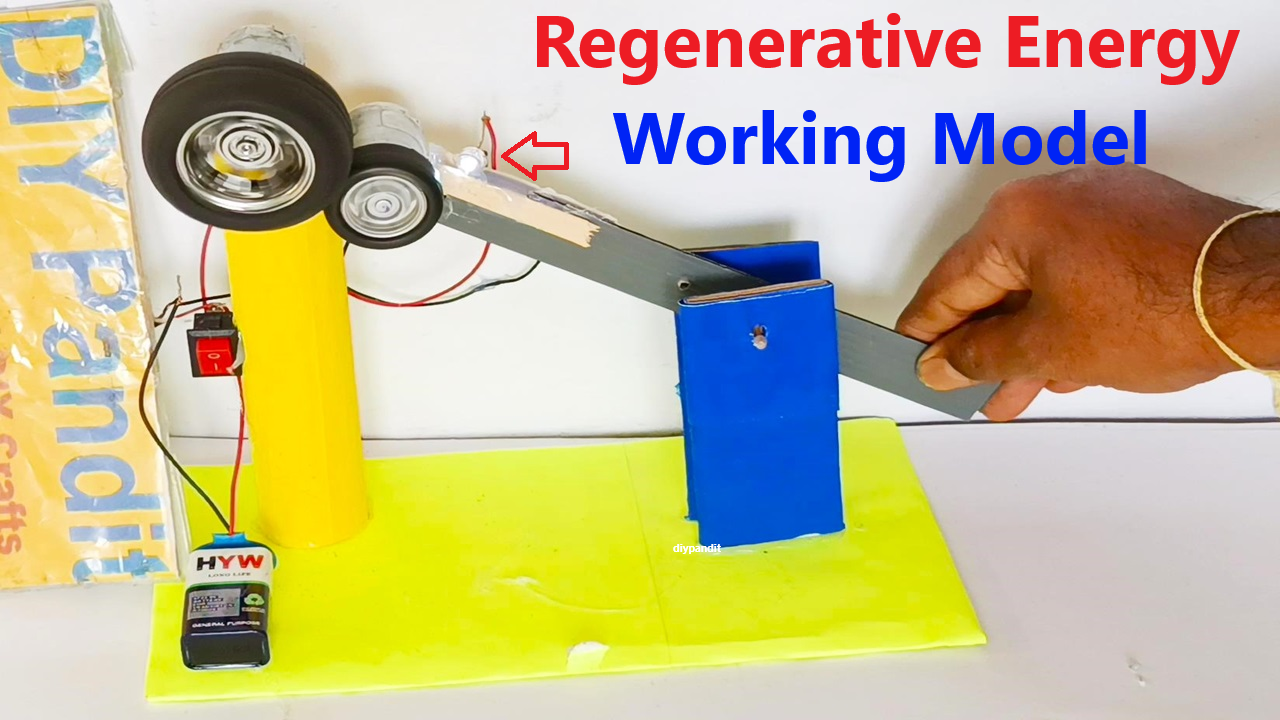Introduction
The world today faces two big challenges: energy shortage and environmental pollution. Traditional energy sources such as coal, oil, and natural gas are limited and release harmful gases when burned. This is why scientists and engineers are working on regenerative energy systems – systems that can reuse, recycle, or regenerate energy instead of wasting it.

A regenerative energy working model is a small-scale project or demonstration that shows how energy can be captured, stored, or reused. These models are excellent for school exhibitions, Inspire Award projects, and college science fairs because they combine innovation, sustainability, and practical science.
What is Regenerative Energy?
Regenerative energy refers to capturing energy that would otherwise be lost and putting it back into use. It can also mean using renewable resources in a way that regenerates naturally, such as solar or wind energy.
Examples of regenerative energy in real life:
- Regenerative Braking in Electric Vehicles (EVs) – Energy from braking is stored in the battery.
- Flywheel Energy Storage – A spinning wheel stores rotational energy for later use.
- Solar and Wind Energy Systems – They regenerate continuously through natural sources.
- Waste-to-Energy Plants – Organic and industrial waste converted into usable energy.
Types of Regenerative Energy Working Models
1. Regenerative Braking Model
- Concept: In electric vehicles, when brakes are applied, the motor runs in reverse and acts as a generator. This regenerates electricity instead of wasting energy as heat.
- Materials Needed: Small DC motor, toy car, rechargeable battery, LED.
- Working:
- As the toy car moves, the DC motor acts as a wheel.
- When brakes are applied (by pressing a lever), the motor generates current.
- This current is stored in a small battery and later lights up an LED.
- Educational Value: Demonstrates how electric vehicles save energy.
2. Flywheel Energy Storage Model
- Concept: A flywheel stores rotational energy and can release it later when required.
- Materials Needed: Bicycle wheel or disk, motor, rubber belt, LED.
- Working:
- Motor spins the wheel (charging phase).
- When motor stops, wheel keeps spinning.
- The spinning wheel drives a small generator to power an LED.
- Educational Value: Teaches energy storage and conversion.
3. Solar Regeneration Model
- Concept: Solar panels convert sunlight into electricity, and the energy can be stored in rechargeable batteries.
- Materials Needed: Small solar panel, rechargeable battery, LED light, fan.
- Working:
- Solar panel generates electricity during the day.
- Stored in battery.
- At night, the battery powers an LED or fan.
- Educational Value: Shows renewable and regenerative power cycle.
4. Wind Turbine with Energy Storage Model
- Concept: Wind turbines produce electricity and store it for later use.
- Materials Needed: Cardboard blades, DC motor, rechargeable battery, LED.
- Working:
- Blowing air rotates blades, generating electricity.
- Power stored in a battery.
- Later used to light up an LED.
- Educational Value: Teaches students about regenerative energy from natural resources.
5. Kinetic Energy Regeneration Model (Playground Energy)
- Concept: Human activities like walking, cycling, or playing can generate electricity.
- Materials Needed: Spring system, piezoelectric discs, or DC motors.
- Working:
- Pressure from footsteps or cycling spins a motor.
- Current is generated and stored.
- Used to light LEDs or charge small devices.
- Educational Value: Shows how daily motion can regenerate energy.
6. Waste-to-Energy Biogas Model
- Concept: Organic waste (food, cow dung, plant leaves) decomposes and produces biogas, which can be used for cooking or lighting.
- Materials Needed: Plastic bottle, inlet for waste, outlet for gas, balloon, tubing.
- Working:
- Waste decomposes in sealed container.
- Gas collected in balloon.
- Balloon used to power a flame (with safety measures).
- Educational Value: Teaches waste recycling into energy.
Benefits of Regenerative Energy Models
- Eco-Friendly – No harmful gases, reduces pollution.
- Cost-Effective – Free sources like sun, wind, and waste are used.
- Practical Learning – Hands-on experience of real-world technologies.
- Inspiration – Motivates students to think about innovative energy-saving ideas.
Future Possibilities of Regenerative Energy
- Electric Vehicles – All modern EVs use regenerative braking. Future designs will make them more efficient.
- Smart Grids – Renewable and regenerative systems will work together to provide continuous electricity.
- Urban Energy Harvesting – Roads, playgrounds, and stations can generate energy from footsteps and vibrations.
- Space Applications – Satellites and space stations already rely on regenerative solar panels.
- Home Applications – Solar rooftops, micro wind turbines, and waste-to-energy systems will power smart homes.
Conclusion
Regenerative energy working models are not just small science projects but miniature versions of tomorrow’s energy systems. From solar and wind turbines to regenerative braking and waste-to-energy plants, each model teaches us how energy can be captured, stored, and reused instead of wasted.
By building such models, students learn about sustainability, innovation, and environmental care. They realize that every bit of energy saved contributes to protecting the planet.
The future will depend on regenerative systems where nothing goes to waste. Whether in electric cars, smart homes, or renewable power stations, regenerative energy is the path forward. Students who explore these models today are the scientists and engineers who will design tomorrow’s clean-energy future.
In short: Regenerative energy models inspire us to think green, act smart, and save energy for generations to come.

